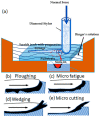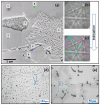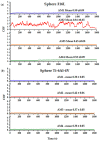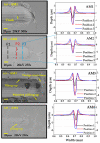Scratch and Wear Behaviour of Co-Cr-Mo Alloy in Ringer's Lactate Solution
- PMID: 37049218
- PMCID: PMC10096074
- DOI: 10.3390/ma16072923
Scratch and Wear Behaviour of Co-Cr-Mo Alloy in Ringer's Lactate Solution
Abstract
Cobalt-chromium-molybdenum (Co-Cr-Mo) alloy is a material recommended for biomedical implants; however, to be suitable for this application, it should have good tribological properties, which are related to grain size. This paper investigates the tribological behaviour of a Co-Cr-Mo alloy produced using investment casting, together with electromagnetic stirring, to reduce its grain size. The samples were subjected to wear and scratch tests in simulated body fluid (Ringer's lactate solution). Since a reduction in grain size can influence the behaviour of the material, in terms of resistance and tribological response, four samples with different grain sizes were produced for use in our investigation of the behaviour of the alloy, in which we considered the friction coefficient, wear, and scratch resistance. The experiments were performed using a tribometer, with mean values for the friction coefficient, normal load, and tangential force acquired and recorded by the software. Spheres of Ti-6Al-4V and 316L steel were used as counterface materials. In addition, to elucidate the influence of grain size on the mechanical properties of the alloy, observations were conducted via scanning electron microscopy (SEM) with electron backscatter diffraction (EBSD). The results showed changes in the structure, with a reduction in grain size from 5.51 to 0.79 mm. Using both spheres, the best results for the friction coefficient and wear volume corresponded to the sample with the smallest grain size of 0.79 mm. The friction coefficients obtained were 0.37 and 0.45, using the Ti-6Al-4V and 316L spheres, respectively. These results confirm that the best surface finish for Co-Cr-Mo alloy used as a biomedical implant is one with a smaller grain size, since this results in a lower friction coefficient and low wear.
Keywords: cobalt–chromium–molybdenum alloy; hip replacements; orthopaedics; scratch test; wear.
Conflict of interest statement
The authors declare no conflict of interest.
Figures














Similar articles
-
Wear Rate, Tribo-Corrosion, and Plastic Deformation Values of Co-Cr-Mo Alloy in Ringer Lactate Solution.Materials (Basel). 2024 May 14;17(10):2327. doi: 10.3390/ma17102327. Materials (Basel). 2024. PMID: 38793394 Free PMC article.
-
Study on improved tribological properties by alloying copper to CP-Ti and Ti-6Al-4V alloy.Mater Sci Eng C Mater Biol Appl. 2015 Dec 1;57:123-32. doi: 10.1016/j.msec.2015.07.046. Epub 2015 Jul 29. Mater Sci Eng C Mater Biol Appl. 2015. PMID: 26354247
-
Tribological behavior of Ti-6Al-4V against cortical bone in different biolubricants.J Mech Behav Biomed Mater. 2019 Feb;90:460-471. doi: 10.1016/j.jmbbm.2018.10.031. Epub 2018 Oct 29. J Mech Behav Biomed Mater. 2019. PMID: 30448560
-
Characteristics of metal and ceramic total hip bearing surfaces and their effect on long-term ultra high molecular weight polyethylene wear.Clin Orthop Relat Res. 1993 Sep;(294):361-78. Clin Orthop Relat Res. 1993. PMID: 8358943 Review.
-
Solids Under Extreme Shear: Friction-Mediated Subsurface Structural Transformations.Adv Mater. 2019 Jun;31(26):e1806705. doi: 10.1002/adma.201806705. Epub 2019 Mar 4. Adv Mater. 2019. PMID: 30828903 Review.
Cited by
-
Wear Rate, Tribo-Corrosion, and Plastic Deformation Values of Co-Cr-Mo Alloy in Ringer Lactate Solution.Materials (Basel). 2024 May 14;17(10):2327. doi: 10.3390/ma17102327. Materials (Basel). 2024. PMID: 38793394 Free PMC article.
-
Optimizing laser cladding powder injection parameters to shape bioactive glass nano-coated zirconium oxide for biomedical application.Heliyon. 2024 Jan 26;10(3):e25277. doi: 10.1016/j.heliyon.2024.e25277. eCollection 2024 Feb 15. Heliyon. 2024. Retraction in: Heliyon. 2025 Apr 30;11(10):e43361. doi: 10.1016/j.heliyon.2025.e43361. PMID: 38318026 Free PMC article. Retracted.
References
-
- Shahini M.H., Mohammadloo H.E., Ramezanzadeh B. Recent approaches to limit the tribocorrosion of biomaterials: A review. Biomass Convers. Biorefinery. 2022:1–21. doi: 10.1007/s13399-022-02719-3. - DOI
-
- Gawad S.A., Nasr A., Fekry A.M., Filippov L.O. Electrochemical and hydrogen evolution behaviour of a novel nano-cobalt/nano-chitosan composite coating on a surgical 316L stainless steel alloy as an implant. Int. J. Hydrogen Energy. 2021;46:18233–18241. doi: 10.1016/j.ijhydene.2021.03.018. - DOI
-
- Cui W., Niu F., Tan Y., Qin G. Microstructure and tribocorrosion performance of nanocrystalline TiN graded coating on biomedical titanium alloy. Trans. Nonferrous Met. Soc. China. 2019;29:1026–1035. doi: 10.1016/S1003-6326(19)65011-9. - DOI
-
- Mazzonello A., Buhagiar J., Chetcuti R., Dearnley P.A., Valsesia A., Colpo P., Mallia B. A tribocorrosion appraisal of a dual layer PVD coated CoCrMo alloy tribopair. Surf. Coat. Technol. 2022;442:128341. doi: 10.1016/j.surfcoat.2022.128341. - DOI
-
- Aherwar A., Patnaik A., Bahraminasab M. Effect of Molybdenum Content on Structure and Properties of a Co-Cr Biomedical Alloy. J. Mater. Eng. Perform. 2019;28:6340–6353. doi: 10.1007/s11665-019-04356-w. - DOI
LinkOut - more resources
Full Text Sources

